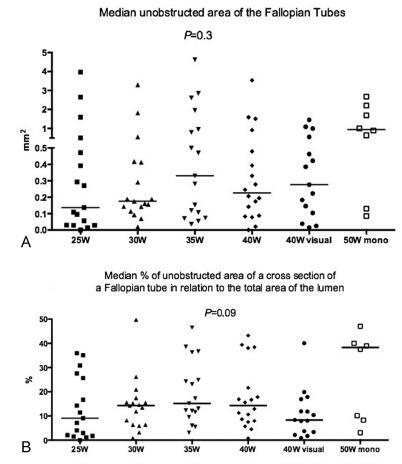Summary
Revista Brasileira de Ginecologia e Obstetrícia. 2018;40(6):332-337
To determine which mode and potency of electrocoagulation, using a modern electrosurgical generator, yields the smallest unobstructed area of the Fallopian tubes.
In an experimental study, tubes from 48 hysterectomies or tubal ligation were evaluated. Tubes were randomly allocated to one of the following groups: group A) 25 W x 5 seconds (n = 17); group B) 30 W x 5 seconds (n = 17); group C) 35 W x 5 seconds (n = 18), group D) 40 W x 5 seconds (n = 20); group E) 40 W x 5 seconds with visual inspection (blanch, swells, collapse) (n = 16); group F) 50 W x 5 seconds (n = 8). Bipolar electrocoagulation was performed in groups A to E, and monopolar electrocoagulation was performed in group F. Coagulation mode was used in all groups. Digital photomicrography of the transversal histological sections of the isthmic segment of the Fallopian tube were taken, and themedian percentage of unobstructed luminal area (mm2) was measured with ImageJ software (ImageJ, National Institutes of Health, Bethesda, MD, USA). The Kruskal-Wallis test or analysis of variance (ANOVA) was used for statistical analysis.
Ninety-six Fallopian tube sections were analyzed. The smallest median occluded area (%; range) of the Fallopian tube was obtained in the group with 40 W with visual inspection (8.3%; 0.9-40%), followed by the groups 25 W (9.1%; 0-35.9%), 40 W (14.2; 0.9-43.2%), 30 W (14.2; 0.9-49.7%), 35 W (15.1; 3-46.4%) and 50 W (38.2; 3.1-51%). No statistically significant difference was found among groups (p = 0.09, Kruskal-Wallis test).
The smallest unobstructed area was obtained with power setting at 40 W with visual inspection using a modern electrosurgical generator. However, no statistically significant difference in the unobstructed area was observed among the groups using these different modes and potencies.
